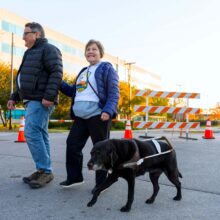Commentary: On 10 Years of the iPhone
On January 9, 2007, Apple’s iPhone was unveiled by the late Steve Jobs in front of thousands of curious spectators. The launch of this new and entirely touch-screen operated cell phone changed the way in which people across the globe interact with technology. For me and countless other individuals with vision loss or other disabilities, the iPhone and similar mobile devices not only gave us greater access to technology, but they also afforded us more independence that previously seemed impossible.
My brother and several friends were among the lucky ones to own that first iPhone from 2007. I always heard excited chatter from them about the cool features it had. “I can even check the weather,” my brother told my relatives in Mexico. At the time touch-screen devices like the iPhone were completely inaccessible to those of us with vision loss, so I could only dream of enjoying that technology. That all changed in 2009 with the launch of the iPhone 3GS, when Apple incorporated Voiceover, its screen-reading software into this and future versions of the iPhone.
Like most of my friends who were blind, I was skeptical and didn’t know if the iPhone would work for me. The thought of being able to use a touch-screen without sight seemed daunting and impossible. It was not until 2012 that I decided to switch to an iPhone after constantly hearing rave reviews from my friends, who were extremely pleased with the accessibility. Their feedback did not disappoint. For the first time in my life, I was able to send and receive text messages on my own thanks to the iPhone. I could also check the weather and email on the go, something that my family and friends took for granted.
Today, the iPhone not only helps me stay in touch with the world, it also gives me more independence. Apps like LookTell Money Reader and TapTapSee allow me to identify things without needing someone’s assistance. With the Bard Mobile and NFB NewsLine apps I can download books, newspapers and magazines in a matter of seconds to listen on my iPhone. The kNFBReader app quickly scans printed documents and reads them out loud to me. Thanks to Voiceover and the built-in accessibility of the camera, I can even take pictures! Finding last minute transportation has become easier thanks to apps like Lyft and Uber, and I can easily find my way to unfamiliar locations with the phone’s GPS.
Without a doubt, the iPhone and other mobile devices have dramatically enhanced the lives of everyone, but even more so for people with disabilities. Technology has changed significantly since 2007, the time when I and other people with vision loss could only dream of being able to use these devices. Kudos to Apple and other manufacturers who are constantly trying to make their devices accessible to everyone. The possibilities with technology are endless, and I am sure it will only continue to help people with and without disabilities connect to the world and live more independent lives.

Sandy Murillo works at The Chicago Lighthouse, an organization serving the blind and visually impaired. She is the author of Sandy’s View, a bi-weekly Lighthouse blog about blindness and low vision. The blog covers topics of interest to those living with blindness and vision impairments. Being a blind journalist and blogger herself, Sandy shares her unique perspective about ways to live and cope with vision loss.





